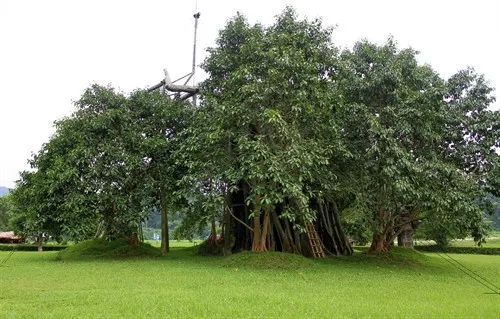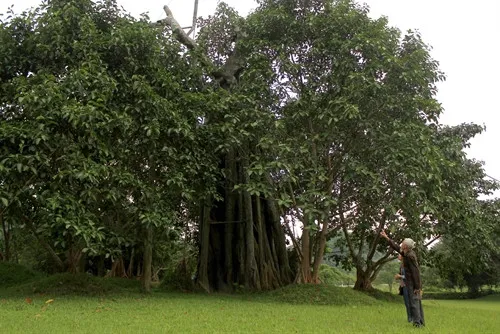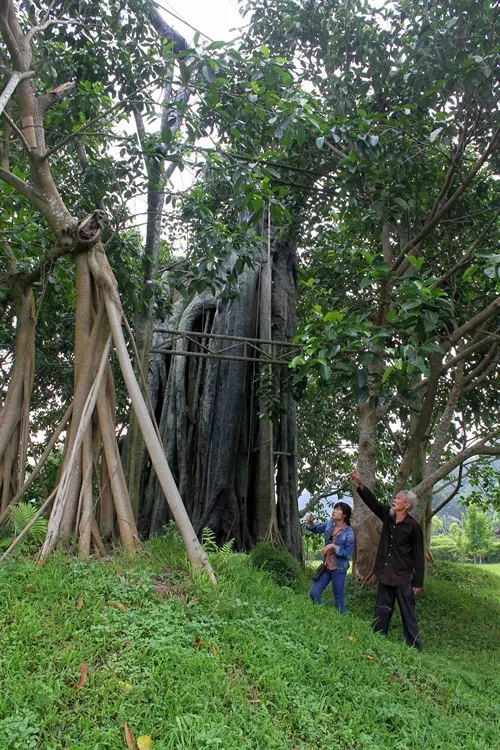Few people know that the symbol of the August Revolution, the Tan Trao Banyan Tree, once faced the threat of extinction. The story of “saving” this ancient tree is not only a testament to the efforts of scientists and officials but also the collective involvement of the community, the locals of Tan Trao. It demonstrates the resilient vitality of Vietnamese history and culture and the steadfastness of people in the face of nature.
The Journey of “Healing” Tan Trao Banyan: From Risk of Extinction to Miraculous Revival
To gain deeper insight into this miraculous journey, we spoke with Mr. Ngo Quoc Lap, the former director of the Management Board of Tan Trao National Tourist, Historical, Cultural, and Ecological Area, who directly participated in the process of “healing” the Tan Trao Banyan Tree. Mr. Lap shared invaluable information about the tree’s condition before restoration and the tireless efforts of a dedicated group.

According to Mr. Lap, the Tan Trao Banyan Tree was initially a cluster of two trees, affectionately called “cây đa ông” and “cây đa bà” by the locals. They stood about 10 meters apart, witnessing the ups and downs of history. However, in 1993, a major storm uprooted the “cây đa ông,” leaving only a small branch. The “cây đa bà” also showed signs of aging, with yellowing leaves and many small branches becoming withered. By early 2008, the Tan Trao Banyan Tree had only one surviving branch facing northeast, but even this branch was barely alive, and the primary roots were almost entirely damaged.
In response to this urgent situation, Tuyen Quang Provincial People’s Committee organized a scientific symposium with the participation of leading experts in forestry, cultural heritage, and scenic organism. The main goal was to find the best approach to “heal” the Tan Trao Banyan Tree. After much discussion and consideration, the approach proposed by Thanh Ha Joint Stock Company was chosen for its feasibility and practical effectiveness.
This approach focused on using biological products to directly influence the tree’s trunk, roots, and foliage. Initially, the product was sprayed every 21 days, later increased to every 7 days to speed up recovery. Simultaneously, the Vietnam Forestry Science Institute successfully grafted 21 branches from the mother banyan to preserve valuable genetic resources and create roots directly on the tree.
Mr. Lap emphasized that the first year was the most crucial, requiring special care. Thanh Ha Joint Stock Company dispatched two employees to stay in Tan Trao for an entire year, working closely with the Management Board to monitor the situation closely and implement timely interventions.
It can be said that those involved in the “healing” project of the Tan Trao Banyan Tree lived and worked wholeheartedly, devoting their complete effort to this “national treasure.” They stayed with the tree day and night, checking, watering, and calculating the appropriate treatment dosage.

Community Involvement: The Strength of Unity
Not only did specialists and officials participate, but the “healing” process for the Tan Trao Banyan Tree also received enthusiastic support from the local community. Mr. Be Van Hai, a resident of Tan Lap Village, volunteered to carry water to irrigate the tree every day before there was a pump. The spirit of solidarity and determination to save the banyan tree spread throughout the community, creating significant strength.
After years of effort, a miracle happened. The historically significant Tan Trao Banyan Tree revived spectacularly. From the scars on the only surviving branch, it now boasts two clusters of roots with dozens of large and small roots. The vast, lush canopy covers an area of up to 60 square meters. Three smaller banyan trees, cloned from the mother tree, are also growing healthily on the trunk. The “cây đa ông,” after being toppled by the storm, has also revived with four vibrant tree bases.
To preserve the dead trunk and main body, Tuyen Quang Province used composite materials to cover the tree trunk and linked it with steel straps. Additionally, a concrete reinforcement and steel pipe support system was installed to brace the remaining live trunk.
Mr. Hoang Ngoc, one of the oldest individuals in Tan Lap Village, shared, “When we saw the Tan Trao Banyan Tree gradually weakening, my fellow villagers and I were very concerned. The banyan tree has been a part of many generations of Tan Trao residents, our pride. Now that it has revived and grown lushly, we are all thrilled and more conscious of protecting the tree.”
Preserving and Promoting Historical Value
Mr. Vien Ngoc Tan, Deputy Director of the Management Board of the Tan Trao National Special Tourist, Historical, Cultural, and Ecological Area, stated that the Tan Trao Banyan Tree is tied to significant historical events of the country. Therefore, in recent years, the Management Board has implemented various measures to preserve and promote the tree’s historical value, such as regular biological product spraying, comprehensive fertilization, frequent inspections and monitoring, and logging the tree’s growth journey.

In the future, the Management Board will continue caring for the Tan Trao Banyan Tree according to technical procedures to ensure its growth and development. Additionally, the roots will be numbered and digitized on computers to track and evaluate the tree’s growth in the most detailed and scientific manner possible.
Conclusion
The historical story of the Tan Trao Banyan Tree is not just a tale about a tree but about the determination, resilience, and unity of the Vietnamese people. The miraculous revival of the Tan Trao Banyan Tree is evidence of the vibrant vitality of history, culture, and belief in a brighter future. The Tan Trao Banyan Tree remains a sacred symbol, reminding us of noble values and the responsibility to protect the legacy of our ancestors.